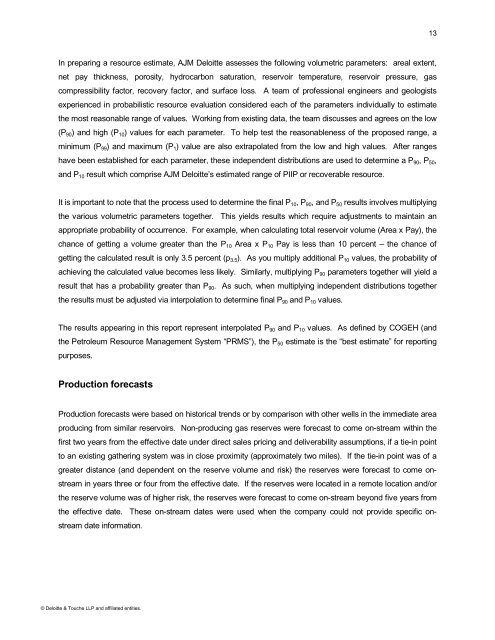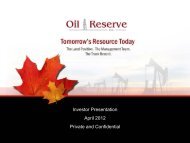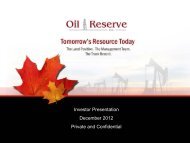Athabasca Viking/Grand Rapids/Nisku Technical ... - Oil Reserve Inc.
Athabasca Viking/Grand Rapids/Nisku Technical ... - Oil Reserve Inc.
Athabasca Viking/Grand Rapids/Nisku Technical ... - Oil Reserve Inc.
Create successful ePaper yourself
Turn your PDF publications into a flip-book with our unique Google optimized e-Paper software.
13<br />
In preparing a resource estimate, AJM Deloitte assesses the following volumetric parameters: areal extent,<br />
net pay thickness, porosity, hydrocarbon saturation, reservoir temperature, reservoir pressure, gas<br />
compressibility factor, recovery factor, and surface loss. A team of professional engineers and geologists<br />
experienced in probabilistic resource evaluation considered each of the parameters individually to estimate<br />
the most reasonable range of values. Working from existing data, the team discusses and agrees on the low<br />
(P 90 ) and high (P 10 ) values for each parameter. To help test the reasonableness of the proposed range, a<br />
minimum (P 99 ) and maximum (P 1 ) value are also extrapolated from the low and high values. After ranges<br />
have been established for each parameter, these independent distributions are used to determine a P 90 , P 50 ,<br />
and P 10 result which comprise AJM Deloitte’s estimated range of PIIP or recoverable resource.<br />
It is important to note that the process used to determine the final P 10 , P 90 , and P 50 results involves multiplying<br />
the various volumetric parameters together. This yields results which require adjustments to maintain an<br />
appropriate probability of occurrence. For example, when calculating total reservoir volume (Area x Pay), the<br />
chance of getting a volume greater than the P 10 Area x P 10 Pay is less than 10 percent – the chance of<br />
getting the calculated result is only 3.5 percent (p 3.5 ). As you multiply additional P 10 values, the probability of<br />
achieving the calculated value becomes less likely. Similarly, multiplying P 90 parameters together will yield a<br />
result that has a probability greater than P 90 . As such, when multiplying independent distributions together<br />
the results must be adjusted via interpolation to determine final P 90 and P 10 values.<br />
The results appearing in this report represent interpolated P 90 and P 10 values. As defined by COGEH (and<br />
the Petroleum Resource Management System “PRMS”), the P 50 estimate is the “best estimate” for reporting<br />
purposes.<br />
Production forecasts<br />
Production forecasts were based on historical trends or by comparison with other wells in the immediate area<br />
producing from similar reservoirs. Non-producing gas reserves were forecast to come on-stream within the<br />
first two years from the effective date under direct sales pricing and deliverability assumptions, if a tie-in point<br />
to an existing gathering system was in close proximity (approximately two miles). If the tie-in point was of a<br />
greater distance (and dependent on the reserve volume and risk) the reserves were forecast to come onstream<br />
in years three or four from the effective date. If the reserves were located in a remote location and/or<br />
the reserve volume was of higher risk, the reserves were forecast to come on-stream beyond five years from<br />
the effective date. These on-stream dates were used when the company could not provide specific onstream<br />
date information.<br />
© Deloitte & Touche LLP and affiliated entities.




